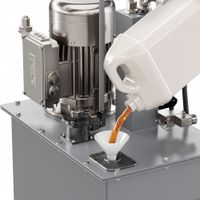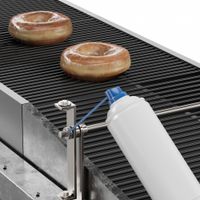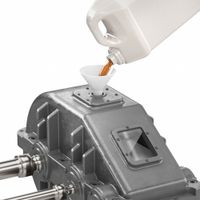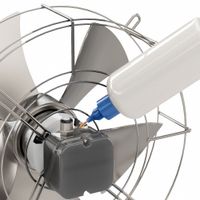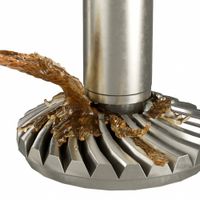Call +(254) 703 030 000 / 751 483 999 / 721 704 777
- Home
- Lubrication
- Oils
.....Read More
Frequently Asked Questions
What are the main functions of oils in machinery?
Oils play several critical roles in machinery, primarily serving as lubricants to reduce friction and wear between moving parts. This lubrication creates a protective film that prevents direct metal-to-metal contact, thereby minimizing heat generation, abrasive wear, and extending the lifespan of components.
Beyond lubrication, oils act as coolants, dissipating heat generated by friction and combustion in engines and other mechanical systems. They also help to clean internal components by carrying away contaminants such as dirt, debris, and sludge, which are then often filtered out.
Furthermore, oils provide corrosion protection by forming a barrier against moisture and oxygen, preventing rust and oxidation on metal surfaces. In hydraulic systems, oil transmits power, allowing for the precise control and movement of heavy loads. They can also dampen shock and noise, contributing to smoother and quieter operation.
In summary, the main functions of oils in machinery are to lubricate, cool, clean, protect against corrosion, and transmit power, all of which are essential for efficient, reliable, and long-lasting mechanical operation.
How do oils differ from grease in terms of application?
Oils and greases are both lubricants, but they differ significantly in their composition and application, making each suitable for specific scenarios.
Oils are typically liquid lubricants composed of a base oil (mineral, synthetic, or vegetable) and various additives. Their fluid nature allows them to flow easily, providing continuous lubrication to moving parts, dissipating heat, and carrying away contaminants. Oils are ideal for enclosed systems with continuous motion and moderate to high speeds, such as engines, hydraulic systems, and gearboxes. They offer superior cooling capabilities and can be easily circulated through pumping systems, ensuring efficient lubrication over large or complex machinery.
Greases, on the other hand, are semi-solid lubricants. They consist of a base oil thickened with a soap or other thickener, along with additives. This semi-solid consistency allows grease to adhere to surfaces, providing a long-lasting lubricant film without dripping or running off. Greases are preferred for applications with intermittent operation, slow speeds, heavy loads, or where it's difficult to retain oil, such as bearings, open gears, and chassis components. They offer excellent sealing properties, protecting components from dust, dirt, and moisture, and reducing the need for frequent re-lubrication.
In summary, the choice between oil and grease depends on the specific application's requirements. Oils are best for continuous, high-speed, and high-temperature operations where heat dissipation and contaminant removal are critical. Greases are more suitable for applications requiring long-lasting lubrication, excellent sealing, and resistance to dripping or slumping, especially in less accessible or harsh environments.
What are the benefits of using hydraulic oils in pressurized systems?
Hydraulic oils are crucial in pressurized systems, offering several benefits that ensure efficient and reliable operation.
Firstly, they act as a medium for power transfer. In hydraulic systems, a pump generates pressure, and the oil transmits this force to actuators (like cylinders or motors) to perform work. Their incompressibility is vital here, allowing for precise and immediate response to commands, which is essential for control in heavy machinery and industrial applications.
Secondly, hydraulic oils provide lubrication to moving parts within the system. Components such as pumps, valves, and cylinders have intricate moving surfaces that can experience significant friction. The oil forms a protective film, reducing wear and tear, minimizing heat generation, and extending the lifespan of the equipment. This lubrication also helps to decrease energy loss, improving overall system efficiency.
Thirdly, these oils aid in heat dissipation. As hydraulic systems operate, friction and fluid shear generate heat. Hydraulic oils are designed to absorb and carry this heat away from critical components, often through a heat exchanger, preventing overheating and potential damage to seals and other materials.
Fourthly, hydraulic oils help to seal clearances between mating parts. This sealing action prevents internal leakage, which could lead to a loss of efficiency and precise control. They also contribute to the overall cleanliness of the system by suspending contaminants and carrying them to filters, which then remove them from the oil.
Finally, many hydraulic oils are formulated with additives that inhibit rust and corrosion. This protects the internal metallic components from degradation due to moisture or chemical reactions, preserving the integrity and performance of the system over time.
Why are food-grade oils important in food and pharmaceutical production?
Food-grade oils are crucial in food and pharmaceutical production for several reasons, primarily concerning safety, quality, and regulatory compliance. These oils are manufactured and handled under strict guidelines to ensure they meet the highest standards for purity and are free from contaminants that could be harmful to human health.
In food production, food-grade oils are used in various applications, including as lubricants for machinery, heat transfer fluids, and as ingredients in food products. Their importance lies in preventing cross-contamination. If a non-food-grade lubricant were to come into contact with food during processing, it could introduce harmful chemicals, allergens, or microorganisms, leading to product recalls, consumer illness, and severe damage to a brand's reputation.
Similarly, in pharmaceutical production, these oils are used in the manufacturing of medications, often as excipients (inactive ingredients that help in the delivery of the active drug) or as lubricants for production equipment. Given that pharmaceuticals are directly ingested or applied to the body, the purity and safety of every ingredient, including oils, are paramount. Food-grade oils ensure that the final pharmaceutical product is safe, effective, and free from any impurities that could cause adverse reactions or compromise the drug's stability.
Beyond safety, using food-grade oils helps manufacturers comply with stringent regulations set by bodies like the FDA and other international health organizations. These regulations mandate the use of safe and approved materials in all stages of food and drug production. Adhering to these standards is not only a legal requirement but also a fundamental aspect of maintaining consumer trust and product integrity.
How do circulating oils work in lubrication systems?
Circulating oils are essential components in many industrial lubrication systems, serving multiple critical functions beyond just reducing friction. Primarily, these oils are pumped continuously through the system, forming a protective film between moving parts to prevent direct metal-to-metal contact, thereby minimizing wear and extending the lifespan of machinery.
Beyond lubrication, circulating oils act as a heat transfer medium. As machinery operates, friction generates heat, which can degrade components and the oil itself. The circulating oil absorbs this heat and carries it away to a cooler, where it dissipates before returning to the system. This thermal regulation is crucial for maintaining optimal operating temperatures and preventing thermal breakdown of the lubricant.
Another vital role is contamination control. As oil circulates, it picks up wear particles, dirt, and other contaminants that can cause abrasive damage. The oil then carries these contaminants to filters, where they are removed, keeping the system clean. Additionally, many circulating oils contain additives that help suspend finer particles, preventing them from settling and causing sludge or deposits.
Furthermore, these oils often contain rust and oxidation inhibitors to protect metal surfaces from corrosion and to resist chemical degradation of the oil itself when exposed to air and high temperatures. Demulsifying agents are also common, allowing water—which can enter the system through condensation or leaks—to separate from the oil, preventing emulsion formation that could reduce lubrication effectiveness and promote corrosion. In essence, circulating oils are sophisticated fluids engineered to lubricate, cool, clean, and protect, ensuring the efficient and reliable operation of complex machinery.
What are the specific uses of gear oils in machinery?
Gear oils are specialized lubricants designed for transmissions, differentials, and other gearboxes. Their primary function is to protect gears from wear, friction, and corrosion, ensuring smooth operation and extending the lifespan of machinery. They achieve this by forming a protective film between gear teeth, reducing direct metal-to-metal contact.
Specific uses of gear oils include: * **Automotive Industry:** Used in manual transmissions, differentials, and transfer cases of cars, trucks, and buses. Different viscosities and additive packages are required depending on the vehicle type and operating conditions.
* **Industrial Machinery:** Essential for gearboxes in various industrial applications like wind turbines, conveyor systems, mining equipment, and manufacturing machinery. These applications often require oils with high load-carrying capacity and thermal stability.
* **Marine Applications:** Used in marine transmissions and propulsion systems, where they must withstand harsh conditions, including exposure to water and salt.
* **Heavy Equipment:** Crucial for construction equipment, agricultural machinery, and off-road vehicles that operate under extreme loads and temperatures.Gear oils contain various additives to enhance their performance, such as extreme pressure (EP) additives to prevent welding of gear teeth under high loads, anti-wear additives, rust and corrosion inhibitors, and anti-foaming agents. The selection of the correct gear oil depends on factors like the type of gears, operating temperature, load, and speed.
How do machine oils benefit moving or threaded parts?
Machine oils provide several key benefits for moving and threaded parts. First, they reduce friction between surfaces, minimizing wear and tear. This is crucial for longevity and efficient operation. Second, oils act as coolants, dissipating heat generated by friction, which prevents overheating and material degradation. Third, they offer corrosion protection by forming a barrier against moisture and other corrosive elements. Fourth, oils help to clean parts by carrying away contaminants like dirt and debris. Finally, for threaded parts, oils ensure smooth engagement and disengagement, preventing galling and stripping while allowing for proper torque application. These combined benefits lead to improved performance, extended component life, and reduced maintenance costs.
What role do divider oils play in food processing equipment?
Divider oils are specialized lubricants used in food processing equipment, particularly in dough dividers and other machinery where food products need to be separated or handled without sticking. Their primary role is to prevent the food product, such as dough, from adhering to machine surfaces, cutting blades, or other components. This non-stick property is crucial for maintaining consistent product shape and weight, ensuring efficient operation, and minimizing waste.
Beyond their non-stick capabilities, divider oils also contribute to the overall hygiene and maintenance of food processing equipment. They often have properties that resist oxidation and microbial growth, which is essential in food contact applications. Furthermore, these oils can reduce friction between moving parts, thereby extending the lifespan of machinery and reducing energy consumption.
It is critical that divider oils used in food processing are food-grade and comply with stringent safety regulations (e.g., FDA or NSF H1 certification). This ensures that in the event of incidental contact with the food product, there is no contamination or adverse health effects. The careful selection and application of divider oils are vital for operational efficiency, product quality, and food safety in the processing industry.
How do oils prevent corrosion and repel water in machinery?
Oils prevent corrosion and repel water in machinery through several mechanisms. They form a protective barrier on metal surfaces, isolating them from moisture, oxygen, and corrosive contaminants. This physical barrier prevents direct contact between the metal and corrosive agents.
Many industrial oils contain rust inhibitors, which are additives that form a thin, durable film on metal surfaces. These films can either neutralize acidic compounds or create a passivating layer that resists chemical reactions. Additionally, oils often contain demulsifying agents or water-separating properties that allow any ingressed water to separate from the oil, preventing it from remaining in contact with metal parts and causing rust.
Furthermore, the hydrophobic nature of oil inherently repels water. This means that water molecules are less likely to adhere to oil-coated surfaces, encouraging water to bead up and run off rather than spread and cause corrosion. This combination of physical separation, chemical inhibition, and water repellency makes oils highly effective in protecting machinery from the damaging effects of corrosion and moisture.
What are the advantages of using oils at higher speeds compared to grease?
Using oils at higher speeds offers several advantages over grease, primarily due to their superior heat dissipation, lower drag, and better flow characteristics. At high speeds, friction generates significant heat, and oils, being fluid, can circulate and carry this heat away from the bearing surfaces more effectively than static grease. This prevents thermal degradation of the lubricant and potential damage to the machinery.
Furthermore, oils generally exhibit lower internal friction and viscosity compared to greases, leading to reduced drag and energy consumption, especially critical in high-speed applications where even small amounts of resistance can translate into substantial power loss and heat build-up. The ability of oils to flow continuously ensures a consistent and complete film of lubricant is maintained across all moving parts, providing more effective protection against wear and corrosion. Greases, while excellent for sealing and providing a long-lasting lubricant film in lower-speed, higher-load, or intermittent applications, can churn and generate excessive heat at high speeds, leading to premature breakdown and reduced efficiency. The continuous replenishment of the oil film also helps to flush away contaminants and wear particles, contributing to extended component life and improved reliability.
